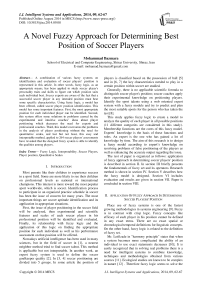A Novel Fuzzy Approach for Determining Best Position of Soccer Players
Автор: Mohammad Bazmara
Журнал: International Journal of Intelligent Systems and Applications(IJISA) @ijisa
Статья в выпуске: 9 vol.6, 2014 года.
Бесплатный доступ
A combination of various fuzzy systems on identification and evaluation of soccer players’ position is represented in this article. In other words, fuzzy logic, as an appropriate means, has been applied to study soccer player's personality traits and skills to figure out which position suits each individual best. Soccer experts are aware of the fact that a successful soccer player in any intended position must bear some specific characteristics. Using fuzzy logic, a model has been offered, called soccer player position identification. This model has some important features: First, the most appropriate position for each individual player can be identified. Second, this system offers some solutions to problems caused by the experimental and intuitive couches’ ideas about player positioning which decreases the need for experts and professional couches. Third, this model overcomes the problems in the analysis of player positioning without the need for quantitative scales, and last but not least, this easy and interpretable method, applied to 264 soccer players' assessments have revealed that the designed fuzzy system is able to identify the qualities among players.
Fuzzy Logic, Interpretability, Soccer Players, Player position, Quantitative Scales
Короткий адрес: https://sciup.org/15010605
IDR: 15010605
Список литературы A Novel Fuzzy Approach for Determining Best Position of Soccer Players
- Bazmara, M. and S. Jafari, K Nearest Neighbor Algorithm for Finding Soccer Talent. Journal of Basic and Applied Scientific Research, 2013. 3(4): p. 981-986.
- Bazmara, M. and S. Jafari, A Fuzzy expert system for goalkeeper quality recognition. International Journal of Computer Science Issues, 2012. 9(5): p. 318-322.
- Hughes, M.D., et al., Moneyball and soccer-an analysis of the key performance indicators of elite male soccer players by position. JOURNAL OF HUMAN SPORT & EXERCISE, 2012. 7(2): p. 402-412.
- Wiemeyer, J., Who should play in which position in soccer? Empirical evidence and unconventional modelling. International Journal of Performance Analysis in Sport, 2003. 3(1): p. 1-18.
- Van Lingen, B., Coaching soccer: The official coaching book of the Dutch Soccer Association. 1998: Reedswain Inc.
- Cook, M., Soccer coaching and team management. 1982: EP Pub.
- SMITH, M., Success in Football. 1993: Butler and Tanner.
- Papić, V., N. Rogulj, and V. Pleština, Identification of sport talents using a web-oriented expert system with a fuzzy module. Expert Systems with Applications, 2009. 36(5): p. 8830-8838.
- Grint, K., Fuzzy management: Contemporary ideas and practices at work. 1997: Oxford University Press Oxford.
- Zadeh, L.A., Fuzzy sets. Information and control, 1965. 8(3): p. 338-353.
- Zadeh, L.A., Outline of a new approach to the analysis of complex systems and decision processes. Systems, Man and Cybernetics, IEEE Transactions on, 1973(1): p. 28-44.
- Jang, J.-S.R., C.-T. Sun, and E. Mizutani, Neuro-fuzzy and soft computing-a computational approach to learning and machine intelligence [Book Review]. Automatic Control, IEEE Transactions on, 1997. 42(10): p. 1482-1484.
- Silvert, W., Ecological impact classification with fuzzy sets. Ecological Modelling, 1997. 96(1): p. 1-10.
- Zimmermann, H.J.r., Fuzzy set theory-and its applications. 2001: Springer.
- Lee, C.-C., Fuzzy logic in control systems: fuzzy logic controller. Systems, Man and Cybernetics, IEEE Transactions on, 1990. 20(2): p. 404-418.
- Ruspini, E.H., P.P. Bonissone, and W. Pedrycz, Handbook of fuzzy computation. 1998: Institute of Physics Pub.
- Mamdani, E.H. and B.R. Gaines, Fuzzy Reasonings and Its Applications. 1981: Academic Press, Inc.
- Takagi, T. and M. Sugeno, Fuzzy identification of systems and its applications to modeling and control. Systems, Man and Cybernetics, IEEE Transactions on, 1985(1): p. 116-132.
- Duraskovic, R., A. Joksimovic, and S. Joksimovic, Weight-height parameters of the 2002 world football championship participants. Facta universitatis-series: Physical Education and Sport, 2004. 2(1): p. 13-24.
- McIntyre, M.C. and M. Hall, Physiological profile in relation to playing position of elite college Gaelic footballers. British Journal of Sports Medicine, 2005. 39(5): p. 264-266.
- Ostojic, S.M., Physical and physiological characteristics of elite Serbian soccer players. Facta universitatis-series: Physical Education and Sport, 2000. 1(7): p. 23-29.
- Raven, P.B., et al., A physiological evaluation of professional soccer players. British Journal of Sports Medicine, 1976. 10(4): p. 209-216.


